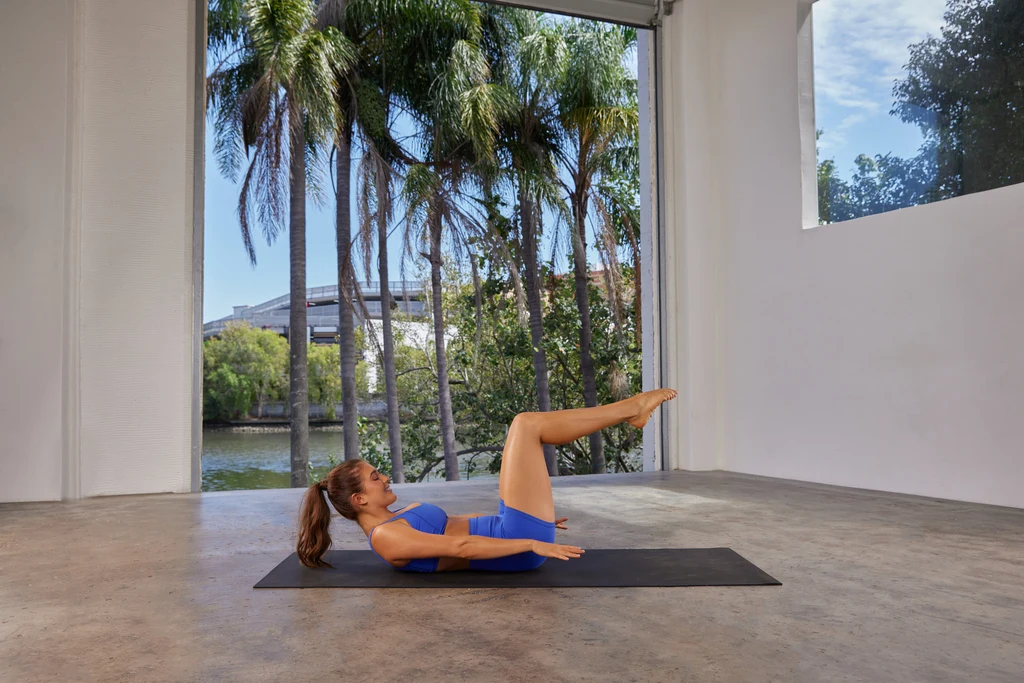There's A Reason The 3-2-1 Method Is So Popular - Here's Why
Not every fitness trend is worth trying. Luckily, there’s a LOT to love about this one.

January 20, 2025 - Updated September 1, 2025

There are some fitness trends that we won’t go near with a 10-foot pole (unless we’re trying them out simply to confirm that yes, they are absurd), but every now and then something blows up on TikTok that we can actually get around. The 3-2-1 method is one of them.
Whether you’ve seen it and want to know if it’s a good way to train or you’re wondering what it even is, here’s the rundown. If this sounds like your ideal new workout routine, The 3-2-1 Method with Katie Martin is available in the Sweat app or you can check out a free workout from the program here.
What is the 3-2-1 method?
The 3-2-1 refers to your weekly split of workouts:
Three strength training sessions
Two Pilates sessions
One cardio session
All up, that’s six sessions per week, plus a full rest day.
Although this is the most common variation of the 3-2-1 method and how Katie’s program is structured, you could switch the ratio of Pilates and strength training around to give Pilates the heavier focus if that’s your preferred training style!
Is there more to it? Nope, that’s it. There are no specific rules about how long your workouts are, how heavy your weights should be, or how challenging your workouts have to feel. And that is the beauty of it.
Why The 3-2-1 Method is so popular
While there’s no universally perfect workout routine, here are nine reasons why we definitely understand the hype and why Katie’s program is a consistent Sweat community favourite.
Structure and consistency: Your weekly workout schedule is clear and consistent, and you know exactly what you’ve got to do each week and when you’ve achieved it.
Flexibility: Although the structure is clear, there is still wiggle room to choose what day you do each workout, how long your sessions are, or how high the intensity is. This also means it's perfect for any fitness level.
Variety: Heaps of variety is automatically baked into each week thanks to the mix of training styles, which is fantastic for your mind and body. If you’re creating your own schedule rather than following the exact workouts in Katie’s program, you could also try using a variety of equipment for your strength and Pilates sessions, and change up your cardio each week.
Holistic approach: A varied schedule means a variety of benefits. Katie loves this workout split for increasing full-body muscle mass through strength training, improving posture, muscle imbalances and injury prevention through Pilates, and improving cardiovascular health through your choice of cardio.
Balance: With three weekly strength sessions, it’s easy to tick off one upper body, one lower body, and one full body session (or a similar split).
Time: Although six sessions per week might sound like a lot - especially if you’re just starting out or you have a hectic week ahead of you - keep in mind that your sessions don’t need to be long every time. You could do four short workouts and a brisk walk, and the workouts in Katie’s program range from 20-45 minutes.
Low-impact: So much variety, yet not a single session involves jumping or exercises that are tough on your joints! Katie loves running for her cardio days but you can obviously choose something else like walking, swimming or cycling.
Progression & results: As you get used to this workout routine, you’ll be ready to lift heavier, do longer workouts, try advanced exercises, or push yourself more.
Sustainability: We love how sustainable The 3-2-1 Method is. You can challenge yourself without burning out or overtraining, increase or decrease your effort depending on how you’re feeling.

Sweat makes it easy
Katie Martin is just as much of a fan of this workout routine as we are, and designed a program that follows this exact structure so the only work you have to do is the workouts themselves!
Her biggest tip for success? On a Sunday or Monday, look at your schedule for the week ahead and map out your six sessions like they’re important meetings.
“Then, remember to fuel your body to perform and recover as best as it can, and set some really clear goals. Preparation and consistency are key for success!” she says.
If you don’t have the equipment required for her program, you can also create your own version of this routine by following another strength training program and adding two Pilates workouts from the On Demand section of the app. Almost all Sweat programs also have a suggested cardio session, meaning you’re automatically getting that done, too. Win-win!
3-2-1… go!
If you’ve been following this trend for a while or love the sound of it and want to get started, start a 7-day Sweat free trial and try out the first week of The 3-2-1 Method with Katie Martin!

Erin is a writer and editor at Sweat with years of experience in women's publishing, the fitness industry, media and tech. She's passionate about the power of movement, and you can often find her on a yoga mat, a hike, a dance floor, in the ocean or the gym.
* Disclaimer: This blog post is not intended to replace the advice of a medical professional. The above information should not be used to diagnose, treat, or prevent any disease or medical condition. Please consult your doctor before making any changes to your diet, sleep methods, daily activity, or fitness routine. Sweat assumes no responsibility for any personal injury or damage sustained by any recommendations, opinions, or advice given in this article.
Fitness